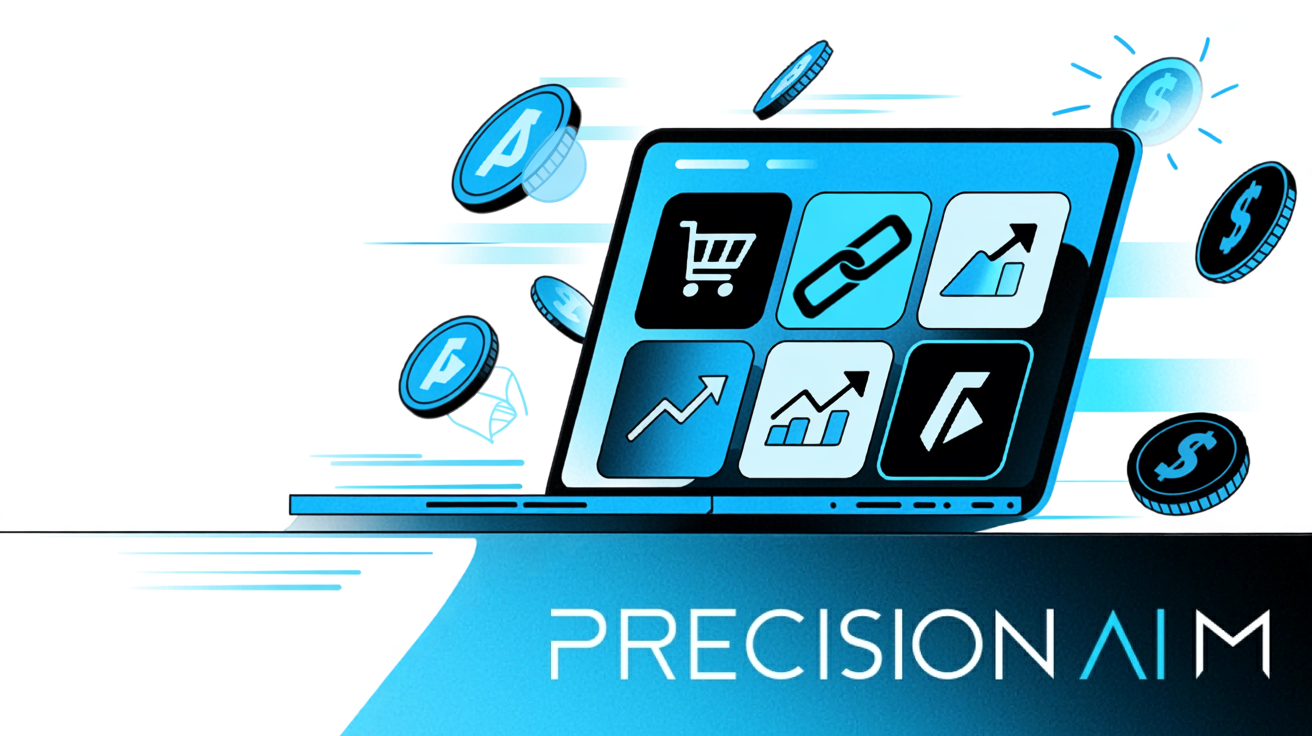Starting an affiliate blog can feel overwhelming, especially if you’re working with a tight budget or limited tech skills. Many people wonder if a free platform like Blogspot is a smart way to get started—or if it’s just too restrictive for real affiliate success.
I’ve tested Blogspot for affiliate marketing and seen both its strengths and its headaches. In this guide, I’ll break down exactly what Blogspot offers, where it falls short, and how to stay compliant with Google and FTC rules. You’ll get a step-by-step setup walkthrough, practical tips for inserting affiliate links, and a clear look at what kind of income you can realistically expect.
I’ll also cover the most common mistakes that get Blogspot affiliate blogs banned, plus how Blogspot stacks up against WordPress and other platforms. By the end, you’ll know if Blogspot fits your goals—or if it’s time to consider an upgrade.
Blogspot affiliate: The basics
What is Blogspot (Blogger)?
Blogspot, more widely known these days as Blogger, is Google’s free, accessible blogging platform. It’s especially appealing if you’re new, a hobbyist, or want to test the waters of blogging without major costs or technical worry.
You benefit from free Google hosting, meaning there’s no setup fee or ongoing cost. Choose either a blogspot.com subdomain or link your own custom domain if you want to build a brand. The content editor is WYSIWYG, making posts simple to create, but you can customise with basic HTML if you know a little code.
Templates are mobile-friendly and quickly get your blog online with a clean look—no extra design software required. Integration with Google Analytics gives you insight into traffic, while AdSense provides a potential revenue boost. To add affiliate content, you simply insert links, banners, or widgets into posts or sidebars.
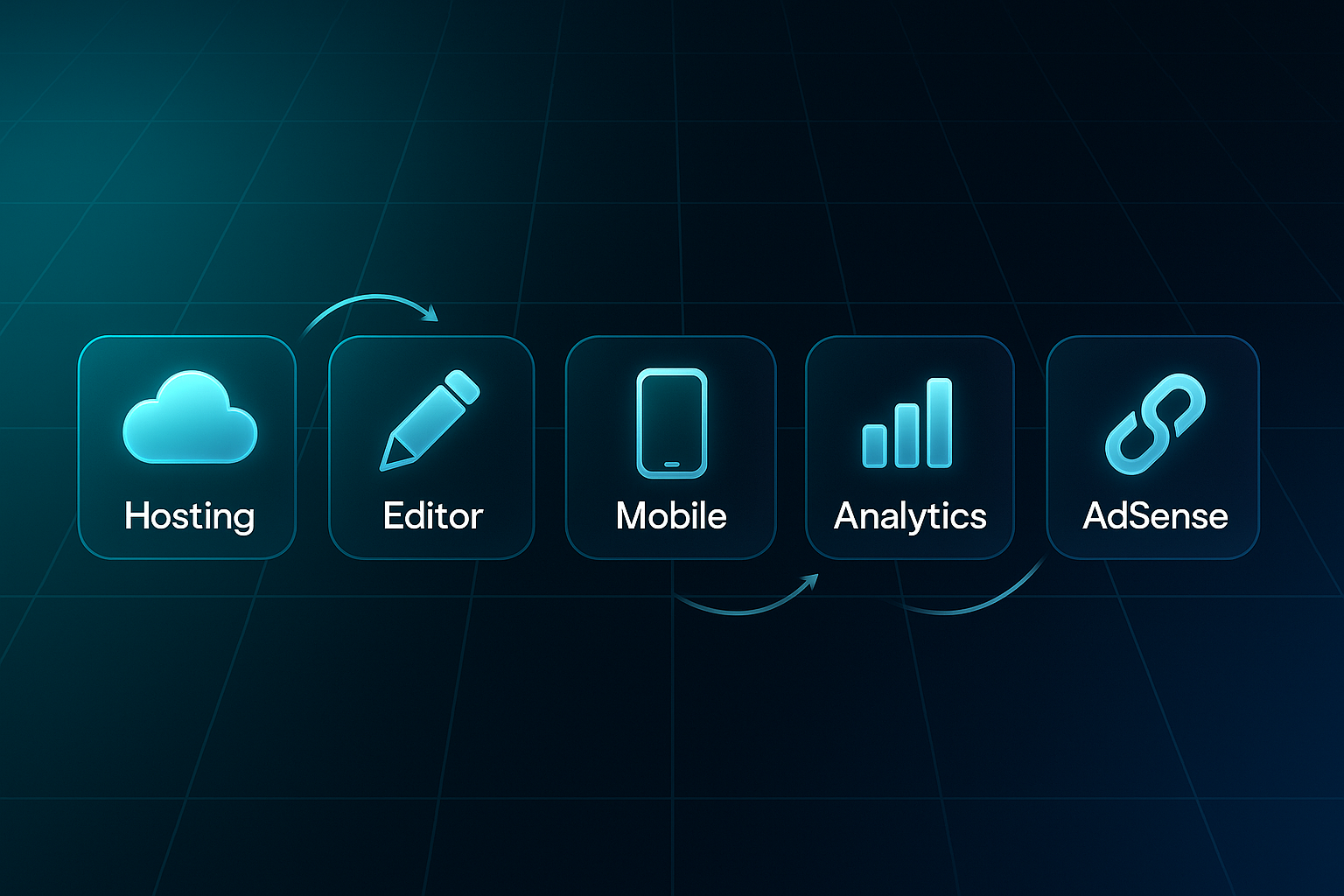
What do we mean by ‘blogspot affiliate’ in this guide?
Here, a “blogspot affiliate” campaign means using Blogspot (or Blogger) as the place to run affiliate marketing. This isn’t about promoting Blogspot itself.
We’re focused on how affiliate marketers use Blogspot to share content packed with affiliate links. It’s aimed both at newbies seeking a free or budget-friendly way in, and those weighing whether Blogspot’s strengths suit their affiliate ambitions.
I started a free blog on Blogspot in a niche that I was passionate about at the time: book reviews. I had no idea what I was doing. I didn’t know about SEO, Pinterest, or building an email list. I just wrote and hoped for the best.
Short answer: Is Blogspot suitable for affiliate marketing?
Yes, Blogspot allows affiliate content and links—but a couple of rules need following.
You must clearly disclose affiliate relationships before any link, satisfying legal and platform expectations. Every affiliate link needs a rel="nofollow" tag, as Google’s guidelines demand.
If you ignore these requirements, your blog risks suspension or removal. Blogspot’s no-cost structure and easy learning curve make it tempting for affiliate beginners, but limited design, analytics, and control make it a tough fit for advanced, large-scale affiliates.
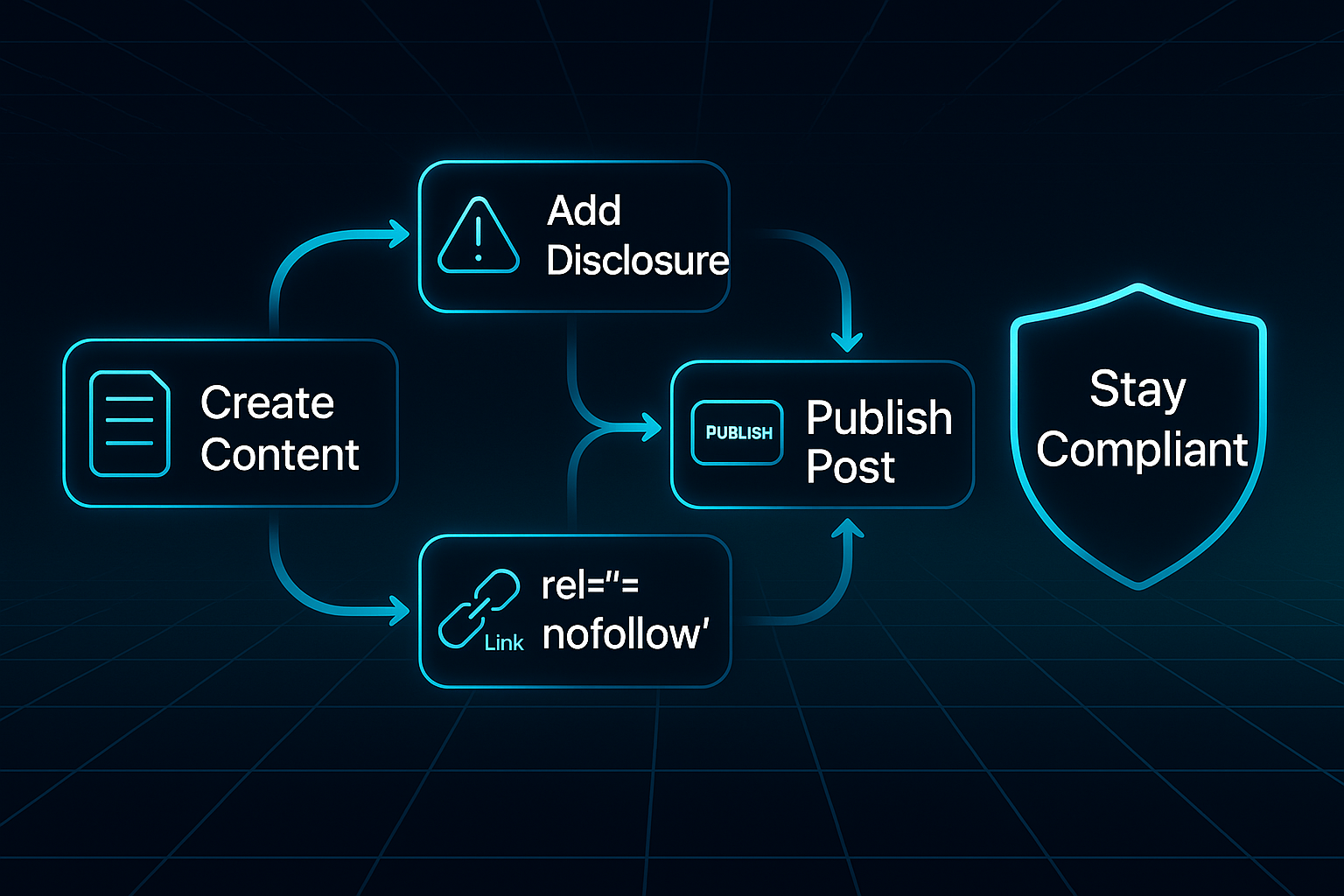
Does Blogspot allow affiliate links? Policies and compliance
Blogger and Google policy basics for affiliates
So, does Blogspot allow affiliate links? You bet—but there’s a key rule: your blog must offer original content, not just page after page of affiliate plugs.
Google draws a hard line against spam, scams, illegal content, adult material, and anything deceptive. Trying to boost traffic with bots or sneaky redirects? That’s a surefire way to get your blog axed.
Google believes that pure affiliate websites with no original content do not provide additional value to web users, especially if they are part of a program that distributes its content across a network of affiliates.
You can run AdSense and affiliate links together, which is handy, but don’t overdo ads or links. Too much and Google’s filters may spot you as spam. There’s more scrutiny now on “affiliate only” pages—if your blog is just a vessel for affiliate SEO, it could be penalised or removed.
FTC and disclosure requirements
Remember, many regions require you to clearly disclose affiliate links wherever they appear in your content. No hiding it at the bottom—a notice belongs right at the top of any post with affiliate links.
Something like: “This post contains affiliate links. I may earn a commission if you purchase through these links, at no extra cost to you.” A transparent site-wide Disclosure or Privacy Policy page is also expected, easily reachable from any device.
Common policy violations that kill blogs
Some mistakes quickly lead to disaster. Recycled or thin content, stacking posts with affiliate links, or being sneaky about where links lead are risky moves.
Promoting illegal, banned, or shady stuff is a fast track to suspension. Skip proper disclosures, or publish only generic, low-quality posts, and you risk losing AdSense, affiliate access, or your entire blog.
Neglecting affiliate marketing compliance isn’t just risky; it could lead to severe financial penalties, damage to your brand's reputation, and other legal consequences.
Practical compliance checklist for Blogspot affiliates
- Disclosure & privacy policies
Legal pages for disclosure and privacy—clearly linked from your homepage. - Contact/About section
Basic author or site info boosts reader trust. - Original, valuable content
Avoid duplicate or automated content—stay unique. - Clear affiliate disclosures
Place a visible notice at the top of every post with affiliate links. - Honest link context
Clearly explain each affiliate link—no tricks. - rel="nofollow" or "sponsored"
Add these tags to any affiliate link, as Google requires.
How to start an affiliate blog on Blogspot: Step-by-step setup
Account and blog creation
Let’s get rolling—you’ll need a Google account for Blogger, so sign up if you haven’t already. Log in at blogger.com, then hit “Create New Blog.”
Pick a blog name that matches your affiliate focus, so visitors immediately know what’s on offer. There's a choice: use the free blogspot.com subdomain, or invest in a custom domain.
A custom domain might cost you, but it signals trust and professionalism, which is vital for affiliate marketing that goes the distance. If you’re just experimenting, a blogspot subdomain is still a quick, no-cost way to launch.
Now onto design. Stick with a clean, mobile-responsive theme—most of your visitors will likely land on your blog from their phones. It’s best to avoid cluttered or difficult layouts; less really is more.
Jump into Blogger’s layout editor to upload your logo, tweak colours, and add navigation links. Simple and inviting beats flashy every time.
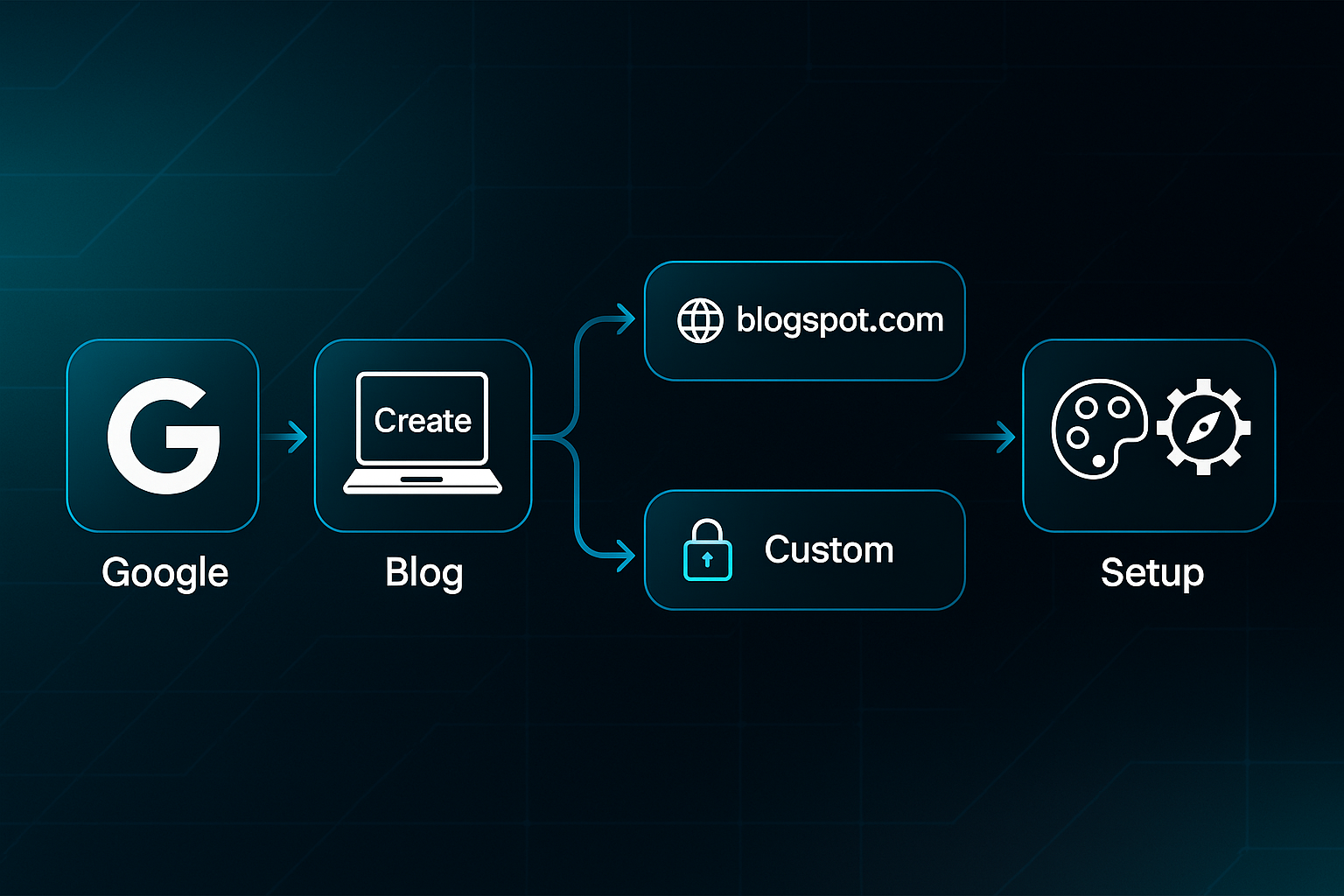
Essential pages and site structure
Before you share your first affiliate post, get these pages sorted:
- About
Builds credibility by sharing who you are and what you’re about. - Contact
Makes it easy for visitors or partners to reach you. - Disclosure/Privacy
Shows your affiliate ties and privacy practices for compliance.
Once created, display these pages in your menus or sidebar for easy access. Use Blogger’s labels—for example, “reviews” or “guides”—to categorise posts and make it easier for readers to find your affiliate content.
Technical settings and analytics
Time to get technical. If you’ve bought a custom domain, connect it under ‘Settings.’
Enable HTTPS for basic security. Add a meta description that targets your affiliate niche so searchers know exactly what you provide.
Insert your Google Analytics ID to start tracking visitors. Register your blog with Google Search Console and submit your sitemap—this helps your blog appear in search results.
Enable comment moderation to block spam. If you want more control, update robots.txt to manage how search engines crawl your blog.
Publishing your first affiliate post
For your first post, pick a topic that helps readers—think reviews or guides tied to your affiliate offer. Write naturally and add affiliate links where they make sense.
Links must use rel="nofollow sponsored", and disclose your affiliate relationship at the top of each post.
Before publishing, double-check content for originality, accuracy, and full policy compliance. One last review protects you from surprises later.
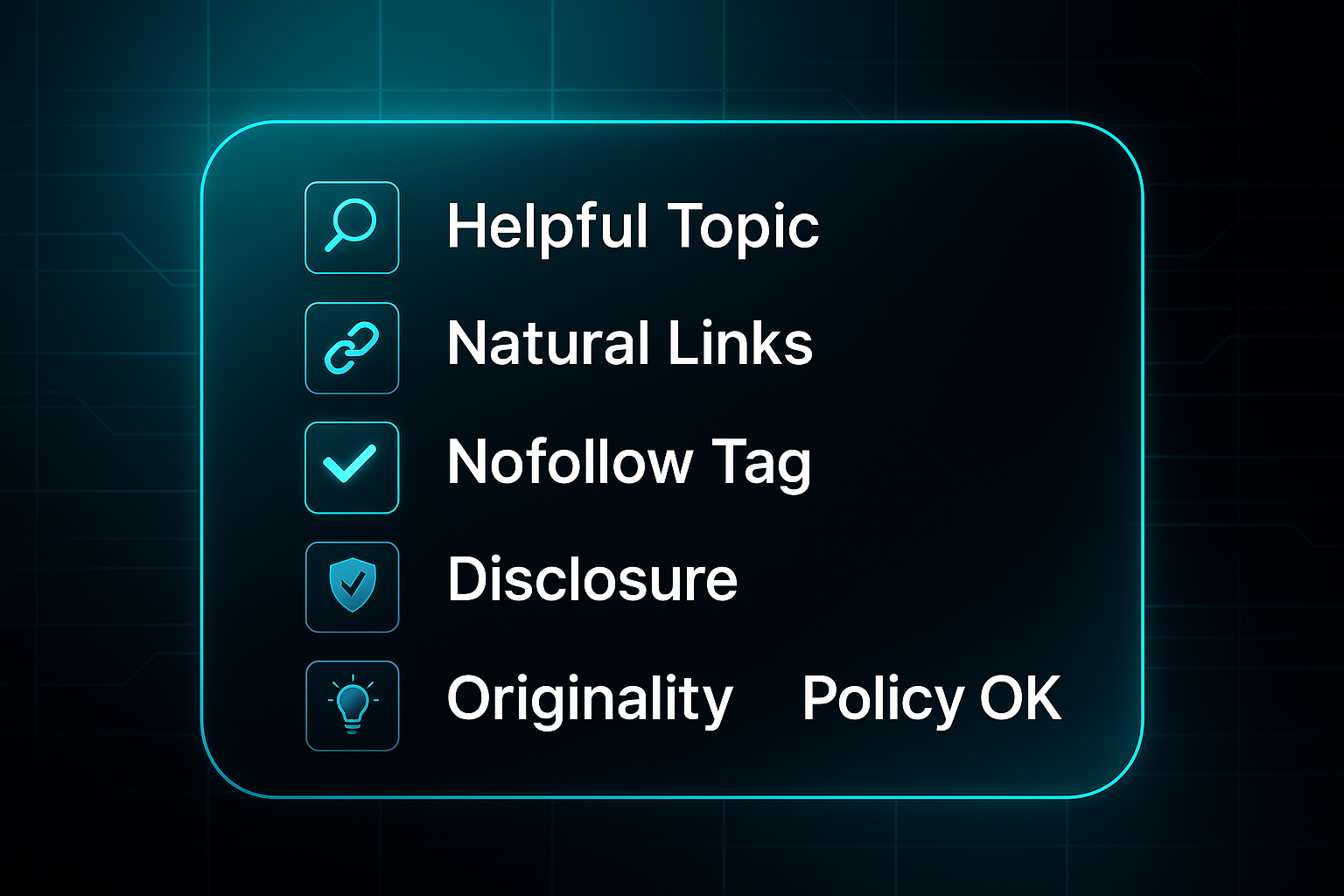
Best practices for inserting and managing affiliate links on Blogspot
Correct link insertion and attributes
Adding affiliate links on Blogspot may look easy at first, but getting it right is vital for your blog’s success. Highlight your chosen text and use Blogger’s “Insert Link” in the editor.
But here’s the thing—after inserting the link, switch to HTML mode to check the code. You should add rel="nofollow sponsored" to every affiliate link. That way, Google and Blogspot recognise it’s a paid link, which helps protect your SEO and reputation.
Links that are part of affiliate programs are considered paid links and should be qualified with rel="sponsored".
Avoid link cloaking, unauthorised shorteners, or sneaky redirects, as these break Blogspot and Google’s rules. Your blog could be removed if you’re caught cutting corners. Always keep link text clear, so readers know exactly where they're headed.
Disclosure placement and wording
Where you place your disclosure is more important than most realise. If any affiliate links appear, a disclosure needs to go right at the top of your post, ideally before any links.
A simple line does the trick: “This post contains affiliate links. I may earn a commission if you purchase through them.”
It’s also vital to have a Disclosure or Privacy Policy page, linked from every part of your site—think footer or sidebar, so it’s always visible.
For frequent posters, keeping a disclosure template and checklist in Blogger keeps things consistent and compliant.
Link tracking and performance monitoring
Tracking which affiliate links perform best makes all the difference. Where possible, use UTM codes—your affiliate network may support them—and monitor via Google Analytics.
Since Blogspot doesn’t offer built-in link tracking, create a spreadsheet that tracks each affiliate URL, placement, and the current offer.
Review your sheet now and then, and check live links—to fix or remove broken or expired ones fast.
Maintenance and hygiene
At least monthly, give your affiliate links a health check. Confirm rel tags and disclosures are correct and live links work.
Remove anything outdated on the spot. For each new post, always double-check compliance. That’s how your Blogspot affiliate site stays healthy and rule-abiding.
SEO and analytics for Blogspot affiliate sites
On-page SEO tasks supported by Blogspot
If you’re setting up SEO on Blogspot, you’ll find the essentials, though most steps are hands-on. Custom meta titles and descriptions? They’re built into the editor—just weave your focus keyword in naturally.
For cleaner, keyword-rich URLs, “Custom Permalink” is your friend. Something like /best-blenders-review helps both readers and search engines.
Don’t forget image alt text. It isn’t just about accessibility; it puts your content in the running for Google Image searches, which means more exposure.
Each post title defaults as H1. Use H2 and H3 subheadings to break up content, slipping keywords into your headings and introductions to help build topical authority.
Labels act like topic tags, keeping similar posts clustered together—making navigation easier and supporting your blog's search visibility.
Internal linking is manual here: add anchor text like “see our blender comparison” to lead both visitors and Google deeper into your content.
Technical SEO limitations and workarounds
Blogspot’s simplicity means some advanced tools are missing.
There’s no plugin marketplace or automated schema support—if you need schema markup, it’s a do-it-yourself job in the HTML.
Your sitemap is auto-generated, but if you reach 500 posts, you might have to upload extra sitemaps via Google Search Console.
Canonical tags handle themselves but barely allow tweaks. For redirects or meta tag edits, every change means digging into HTML for each post.
And if you’re after speed tricks like lazy loading, forget it. Stick with compressing images and removing extra gadgets to help pages load faster.
Tracking performance and conversions
Adding Google Analytics just means popping your property ID into settings—now you can follow traffic and user behaviour.
For affiliate links, add UTM tags to URLs or use Google Tag Manager for advanced click tracking, though this needs a touch of HTML editing.
You can’t use pixels for conversion tracking, so get your sales/conversions straight from your affiliate network’s dashboard. Want click stats in one place? Bitly or ClickMeter do the trick.
Blogspot SEO gives you the basics—you bring the dedication.
Monetisation strategies and realistic income potential on Blogspot
Effective monetisation mix for Blogspot
Looking to earn from your Blogspot blog? You have two main routes: Google AdSense and affiliate links. Both are simple to start and don’t need advanced skills or big investments.
AdSense ads fit neatly in sidebars, footers, or between posts. But keep it light—just one or two ads per page. Too many ads or affiliate links will annoy visitors and could trigger Google penalties.
When adding affiliate links, only use them in posts that genuinely help your readers. Reviews, tutorials, listicles, and comparisons feel natural for this sort of monetisation and still offer plenty of value.
Blogspot works best in information-rich, hobbyist, or low-competition niches. Think recipes, crafts, books, or uniquely local subjects.
If your aim is high-ticket tech, finance, or B2B, you’ll soon outgrow Blogspot’s capabilities. Ambitious sites often need more flexible tools for serious income growth.
A case study of a travel blog, treated as a hobby project, revealed it was possible to earn over $7,300 in mostly passive income in a single year, even when the niche was hit hard by a global downturn.
Keep most posts focused on offering real value, with a modest, clearly disclosed slice dedicated to monetisation. This keeps trust and compliance firmly on your side.
What realistic early earnings look like
So, what can you genuinely expect in the beginning? AdSense rates usually fall between £1.50–£3.50 CPM. Affiliate clicks bring in £0.05–£0.30, but conversion rates rarely exceed 2%.
Most people starting out see £5–£40 monthly. With ongoing effort in the right niche, reaching £80–£200/month is achievable within several months.
Blogspot’s gradual pace lets you test affiliate strategies without big risks. Ready for more? A flexible platform unlocks even bigger earning potential.
Risks, common mistakes, and how to avoid being banned
High-risk behaviours to avoid
Thin or auto-generated content
Posting spun, copied, or AI-generated articles puts your blog at risk. Article spinners or reposted feeds wreck credibility and can get you banned. Stick to original, useful posts.
Excessive affiliate links with no value
Cramming links into posts without valuable content quickly erodes trust and leads to penalties. Add links only when they benefit your readers.
Cloaking and misleading redirects
Masking affiliate destinations, using sneaky shorteners, or showing Google different content all break policy. Always stick to honest, open linking.
Promoting restricted products
Sharing adult, gambling, finance, health offers, or illegal products is an instant ban. Keep an eye on Blogger’s Content and Publisher Policies as rules can change.
Auditing and proactive risk management
- Routine content audits
Check monthly for originality and working links. - Content backups and export
Export your blog regularly as protection. - Monitoring terms & policies
Review Blogger and affiliate rules each quarter. - Monetisation pacing and moderation
Prioritise strong content—sprinkle affiliate links, don’t overdo it.
Responding to warnings or flagging
- Immediate corrective actions
Fix breaches and disclosures fast, then resubmit. - Crafting an effective appeal
Contact support, explain your actions, and confirm compliance.
Stay vigilant and you’ll keep your Blogspot affiliate site thriving—without the stress of sudden bans.
Blogspot vs other platforms for affiliate marketing: Which should you pick?
Blogspot vs self-hosted WordPress
Thinking about where to begin as an affiliate—Blogspot or self-hosted WordPress? The main difference is flexibility and your ambitions.
WordPress brings a powerful set of plugins, like ThirstyAffiliates or Pretty Links, that take care of link cloaking, tracking, and compliance automatically. This makes scaling up and staying compliant much easier as your blog grows.
Blogspot is free and simple. But everything—from affiliate link tracking to compliance—is up to you, with no automation. If you want control with less manual work, WordPress has the upper hand.
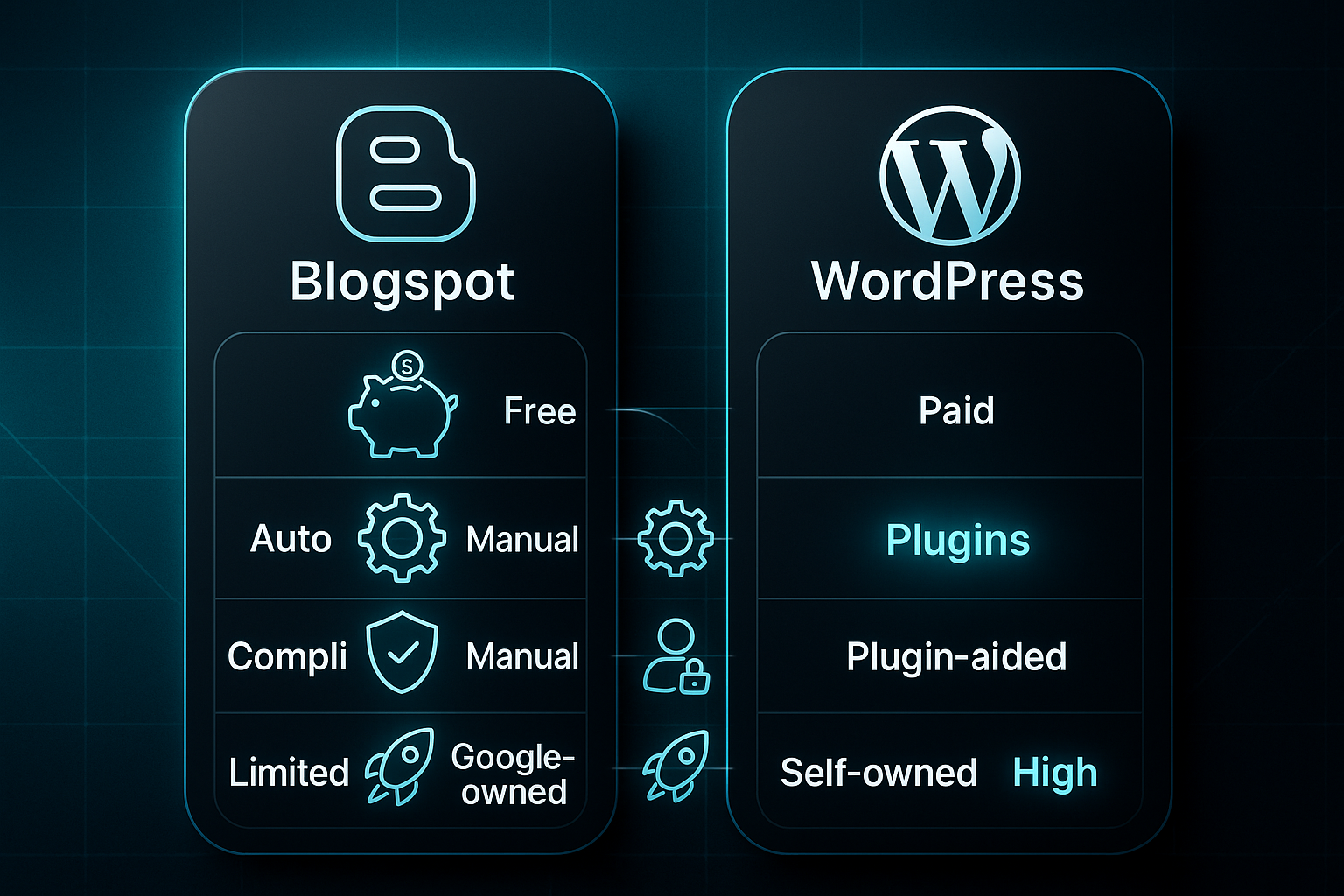
There’s also the question of ownership. On WordPress, you’re fully in charge: your content, your hosting. Blogspot is always under Google’s rules—break them, and your blog could disappear. For anyone who wants to run multiple sites or unlock advanced earnings, WordPress is built for expansion, while Blogspot suits smaller, hobby-style projects.
| Feature | WordPress.org (Self-hosted) | Blogspot |
|---|---|---|
| Customisation | 60,000+ plugins, full code access | Basic templates, limited tweaks |
| Affiliate Tools | Plugins automate everything | Manual, no automation |
| Content Ownership | Fully yours | Controlled by Google |
| Scaling | Unlimited, bigger projects | Suits hobby/small blogs |
| Earnings Potential | Diverse, higher ceiling | Mainly AdSense, affiliate |
| Ongoing Cost | Needs hosting and domain | Free unless custom domain |
Blogspot vs WordPress.com / Wix / Squarespace
How do free platforms stack up? Blogspot and Wix are both free at first, but Wix keeps its best features behind a paywall. WordPress.com restricts plugins and affiliate links unless you pay. Squarespace is paid-only—the best affiliate features cost extra.
The trend? Free platforms limit monetisation and analytics until you upgrade. Growing affiliates usually switch for better tools.
When to upgrade—and SEOSwarm as an option
When Blogspot feels restrictive—maybe compliance or link tracking is overwhelming—it’s time to consider an upgrade.
Here, SEOSwarm steps up. With an AI-driven SEO blog editor and automated compliance, it’s ideal if you want to scale your affiliate efforts without extra busywork.

AI-Powered Content Strategy
See the AI platform that's replacing entire content teams (with better results).

When and how to upgrade from Blogspot: migration and advanced options
Signs it's time to migrate
Ever find Blogspot feeling restrictive? If you’re craving schema markup, advanced SEO tweaks, or faster page speeds, those limits become clear.
Managing affiliate links by hand, sorting out compliance alone, or struggling to keep content organised—these all signal it’s time to upgrade. The need for click tracking and automation is another nudge you can’t ignore.
Migration checklist and planning
Ready to make a move? Step one: back up your Blogspot blog so nothing important gets left behind. Audit your top posts and best affiliate links—you don’t want to lose a high performer in the shuffle.
Use Blogger Importer (or a similar tool) to transfer content, plan new URLs, and set up 301 redirects to protect SEO. Audit affiliate links, add disclosures, restore tracking, and create a fresh sitemap for Google Search Console. Keep an eye on analytics to catch any drop in clicks or earnings early.
Advanced options after migration
Switching to self-hosted WordPress gives you powerful automation and affiliate plugins for seamless growth. Or, if you’d rather skip the hassle, SEOSwarm offers AI-driven content, SEO, and compliance—an all-in-one path to scalable affiliate success.
My Honest Take on Blogspot Affiliate Efforts
Most people underestimate how much manual effort Blogspot demands for affiliate marketing. Free and simple is appealing, but every link, disclosure, and compliance step is on you—there’s no safety net or automation.
If you’re just starting out, Blogspot is a low-risk way to learn the ropes and test affiliate strategies. Here’s what I recommend: - Focus on original, helpful content—never just links. - Add clear disclosures and rel="nofollow sponsored" tags to every affiliate link. - Audit your posts monthly for compliance and broken links. - Track your results in a spreadsheet, since Blogspot lacks built-in analytics for affiliates.
When you find yourself spending more time on manual tasks than growing your income, it’s time to upgrade. Blogspot is a great launchpad, but real affiliate growth comes from platforms that automate compliance, tracking, and SEO. Start simple, but don’t be afraid to evolve—your affiliate business should grow as your ambitions do.
- Wil
